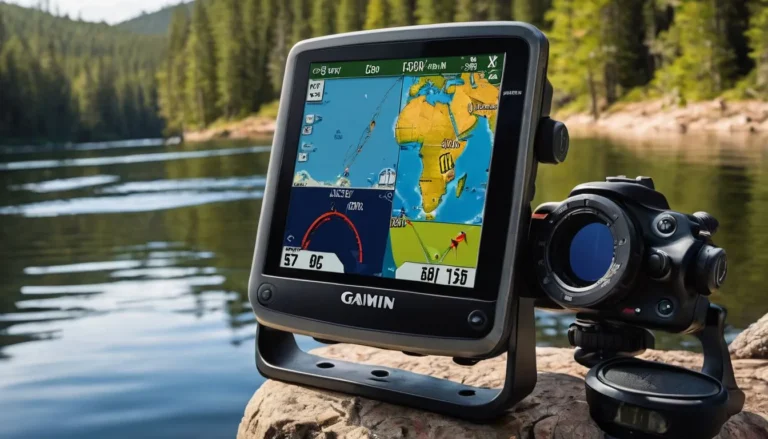How to Download Maps on Garmin Fish Finder?
Are you struggling to make the most of your Garmin fishfinder because you’re not sure how to download maps? It’s a breeze once you know the right steps.
In this guide, we’ll walk through the process so that next time you’re on the water, you’ll have all the fishing hotspots and contours at your fingertips.
Discover new depths with precision, ensuring your angling adventures are fruitful.
Continue reading for map mastery!
Key Takeaways
- Download maps onto a Garmin fish finder by installing Garmin Homeport or Active Captain, using an SD card of 8 GB or less.
- Import personal fishing spots and download over 600,000 from the Quickdraw Community using Garmin Connect on iOS devices.
- Reset your device if you encounter issues by entering Maintenance Mode and selecting ‘Factory Reset’ to restore default settings.
Understanding the Garmin Fish Finder and its Features
Delving into the capabilities of your Garmin Fish Finder opens up a new realm of precision and efficiency for your aquatic adventures.
This high-tech sonar device is engineered not only to enhance your fishing experience but also to navigate waters with greater confidence through its robust feature set, including advanced mapping technologies like ECHOMAP™ Plus and integration possibilities with Active Captain.
ECHOMAP™ Plus
ECHOMAP™ Plus elevates your fishing game by offering a clear and detailed view of the underwater environment. With this advanced technology, you gain access to high-definition mapping that showcases crisp contours and pinpoint navigation.
You can effortlessly chart your favorite fishing spots and trust in its precise sonar capabilities to locate fish.
Syncing ECHOMAP™ Plus with mobile devices is straightforward, whether you’re an iOS or Android user. Launch the Active Captain app on your phone or tablet, connect via Wi-Fi, and manage your marine experience directly from your device.
This seamless integration means you can quickly download the latest maps before you boot up your Garmin Fish Finder for another successful day on the water.
Active Captain
ActiveCaptain revolutionizes the way anglers access valuable fishing spot information. With this feature, users can easily download GPX files, tapping into a vast database of over 600,000 fishing locations.
The process is straightforward and user-friendly; just connect to Active Captain via your compatible Garmin device or through the app on your Android or iOS smartphone. Imagine having insights from seasoned veterans and retired captains right at your fingertips—this tool makes it happen by allowing seamless import of prime fishing spots directly from Google Earth or any supported browser.
Your next step involves importing these prized locations into your Garmin fishfinder. This integration is not only about having data but also making sure you can leverage technology for an improved fishing experience.
Let’s dive into how you can import these spots effortlessly.
Procedure to Download Maps on Garmin Fish Finder
When embarking on the journey to enhance your Garmin Fish Finder with detailed maps, the procedure involves a series of steps tailored to integrate crucial navigational aids into your device.
From importing prime fishing spots to tapping into the collective wisdom of the Quickdraw Community, this guide walks you through seamlessly adding that critical underwater intelligence that could be the difference between an empty cooler and a bountiful catch.
Importing Fishing Spots into Garmin
Importing fishing maps into your Garmin fishfinder can significantly enhance your angling experience. Here’s a step-by-step guide to bringing those invaluable fishing spots to your device with ease:
- Start by ensuring you have all the necessary equipment: a Garmin GPS unit, a computer (PC or Mac), and a fresh SD card that is 8 GB or under, as recommended.
- Install Garmin Homeport or Active Captain on your computer, which will allow you to manage maps and waypoints for your Garmin device.
- Prepare your SD card by creating a ‘Garmin’ folder if one doesn’t already exist; this is where some units require the files to be located.
- Download the GPX file containing the fishing spots from a reputable source or use Active Captain to obtain Quickdraw Community Maps on an iOS device.
- Connect the SD card to your computer, either directly via an SD card slot or using an appropriate adapter.
- Copy the downloaded GPX file to the ‘Garmin‘ folder on your SD card; handheld units also support this method by connecting directly to the computer.
- Safely eject the SD card from your computer once the transfer is complete, ensuring data integrity.
- Insert the SD card gently into your Garmin fishfinder’s designated slot, typically found under a protective cover or within a battery compartment, depending on the model.
- Turn on your Garmin GPS unit and navigate to NAV INFORMATION > USER DATA > MANAGE CARD > MERGE FROM CARD, or follow similar steps outlined for different models in their respective manuals.
- Follow any additional on-screen instructions that may appear in order to successfully import fishing spots onto your Garmin device.
Using Garmin Connect for Downloading Quickdraw Community Maps
Harness the power of Garmin Connect to enhance your fishing experience with custom Quickdraw Community Maps. This tool lets you access over 600,000 unique fishing spots, including key locations like buoys and shipwrecks.
- Install the Garmin Connect app on your iOS device from the Apple App Store.
- Open Garmin Connect and select ‘Quickdraw Community‘ in the menu to browse various fishing maps.
- Look for maps that cover your desired fishing area by entering specific search criteria.
- Choose a map from the list and tap on it to view more details, like depth contours and user comments.
- Download the map onto your iOS device; ensure you have a stable internet connection to prevent any interruption during this process.
- Connect your Garmin fish finder to your mobile device via Bluetooth or Wi-Fi, depending on your model’s capabilities.
- Transfer the downloaded Quickdraw Community Map from your iOS device to your Garmin Fishfinder following the prompts in the app.
- Verify that the map has been successfully installed by checking under ‘Chart Options‘ or ‘Map Selection’ on your fishfinder screen.
Creating Your Own Fishing Spot Card
After exploring the Quickdraw Community Maps, take your fishing to the next level by creating a personalized fishing spot card. This allows you to mark and save your favorite locations for future adventures.
- Begin by installing Garmin Homeport or Active Captain on your computer. Choose the software compatible with your operating system, whether it’s a PC or Mac.
- Connect a fresh SD card to your computer using an SD card reader. It’s best to use an 8 GB card or smaller to avoid compatibility issues.
- Open the Garmin software on your computer and navigate to the ‘My Data‘ section.
- Select ‘Create New Fishing Spot‘ and pinpoint the locations on the map that you wish to save. Give each spot a unique name that easily identifies it later.
- Add details about each location, such as depth, water conditions, or fish species commonly found there. The more information you include, the better prepared you’ll be for future trips.
- Once you’ve marked all your spots, export them from Homeport or Active Captain as a GPX file directly onto your SD card, securely housed in the reader.
- Safely eject the SD card from your computer once all data has been transferred successfully.
- Insert the SD card into your Garmin fish finder and power on the device. Your GPS unit will read from the SD card and integrate your custom fishing spots into its onboard maps.
- To ensure that everything is loaded correctly, check that each of your saved fishing spots appears on the device’s display.
Troubleshooting: Resetting Your Garmin Fish Finder
Resetting your Garmin Fish Finder can resolve a host of issues, from glitches to unresponsive screens. This process restores the system to its factory settings, often clearing up software hiccups. Here’s how you can get your device back in shape:
- Begin by powering off your Garmin Fish Finder completely.
- Hold down the power button for a few seconds to turn the device back on.
- As the device powers up, watch for the Garmin logo on the screen; immediately hold down both the ‘zoom in‘ and ‘zoom out‘ buttons simultaneously.
- Continue holding these buttons until the system asks if you want to enter ‘Maintenance Mode‘.
- Select ‘Yes‘ to initiate Maintenance Mode, which will present you with several options.
- Look for and select the ‘Restore Defaults‘ or ‘Factory Reset‘ option within this menu.
- Confirm that you wish to reset all user data when prompted.
- Wait as your fishfinder restarts; this may take a couple of minutes while it restores its original settings.
- Check if any error messages are gone and if functionality is restored post-reset.
Conclusion
Now you have the know-how to enhance your Garmin fish finder with downloadable maps. With a fresh SD card and a few taps, you can import fishing spots and embark on new adventures equipped with valuable data.
Remember these steps next time you’re preparing for a day on the water, ensuring your Garmin is as ready as you are. Happy fishing!
If you encounter any issues or need to reset your device, our step-by-step guide on how to reset your Garmin fish finder can help.
FAQs on Downloading Maps on Garmin Fish Finder
Gary Burrell
Born in 1989, Gary Burrell is an Electrical Engineering graduate from the University of Tennessee. With 20+ years of experience, he has transitioned from engineering roles to becoming the Chief Content Editor. Gary’s unique blend of technical knowledge and editorial expertise has made him an essential figure in content creation, ensuring clarity and accuracy. His journey from an engineer to an editor showcases his adaptability and commitment to continuous learning.




